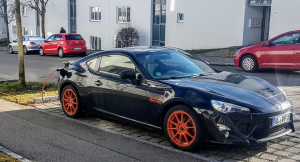I want a powerful EV Conversion: Difference between revisions
No edit summary |
|||
| Line 1: | Line 1: | ||
[[File:GT86.png|thumb|[https://openinverter.org/forum/viewtopic.php?t=326 Toyota GT86 with Nissan Leaf Motor]]] | [[File:GT86.png|thumb|[https://openinverter.org/forum/viewtopic.php?t=326 Toyota GT86 with Nissan Leaf Motor]]] | ||
power density vs energy density | |||
hybrid batteries are ideal for performance applications being that they are smaller, and lighter than traditionally full size packs. they lack the range, but have high power density, allowing for large amounts of power draw. | |||
higher peak power vs higher continuous power | |||
the original tesla large drive units have a very high peak power, ie they can deliver 500-600hp momentarily. great for 0-60 times. | |||
but track racing? a motor with higher continuous power ratting becomes more ideal, such as the model 3 motor. | |||
[[File:Der Panzer.png|thumb|[https://openinverter.org/forum/viewtopic.php?t=29 Tesla Powered BMW E31]]] | [[File:Der Panzer.png|thumb|[https://openinverter.org/forum/viewtopic.php?t=29 Tesla Powered BMW E31]]] | ||
=== components === | === components === | ||
[[File:Boxster EV.png|thumb|[https://openinverter.org/forum/viewtopic.php?t=210 Porsche Boxster 986 Tesla conversion]]] | [[File:Boxster EV.png|thumb|[https://openinverter.org/forum/viewtopic.php?t=210 Porsche Boxster 986 Tesla conversion]]] | ||
- motor & powerful inverter ([[Tesla Model 3 Rear Drive Unit]], [[Tesla Model 3 Front Drive Unit|Tesla Model 3 Front Drive Unit,]] [[Tesla Inverter FAQ]] ) | - motor & powerful inverter | ||
* ([[Tesla Model 3 Rear Drive Unit]], | |||
* [[Tesla Model 3 Front Drive Unit|Tesla Model 3 Front Drive Unit,]] | |||
* [[Tesla Inverter FAQ]] ) | |||
* tuned Nissan leaf motor (140kw, 160kw) | |||
- batteries with high allowable discharge rate | |||
* ([[Tesla Model 3 Battery]]) | |||
* chevy volt battery | |||
* pacifica hybrid modules | |||
- | - DC/DC converter(can be omitted for drag racing) | ||
* ([[Tesla Model S DC/DC Converter]]) | |||
- charger (can be off-vehicle) ( X ) | - charger (can be off-vehicle) ( X ) | ||
Revision as of 17:07, 13 December 2022

power density vs energy density
hybrid batteries are ideal for performance applications being that they are smaller, and lighter than traditionally full size packs. they lack the range, but have high power density, allowing for large amounts of power draw.
higher peak power vs higher continuous power
the original tesla large drive units have a very high peak power, ie they can deliver 500-600hp momentarily. great for 0-60 times.
but track racing? a motor with higher continuous power ratting becomes more ideal, such as the model 3 motor.

components

- motor & powerful inverter
- (Tesla Model 3 Rear Drive Unit,
- Tesla Model 3 Front Drive Unit,
- Tesla Inverter FAQ )
- tuned Nissan leaf motor (140kw, 160kw)
- batteries with high allowable discharge rate
- (Tesla Model 3 Battery)
- chevy volt battery
- pacifica hybrid modules
- DC/DC converter(can be omitted for drag racing)
- charger (can be off-vehicle) ( X )
If you are looking for a cheap ev conversion check the sister page.